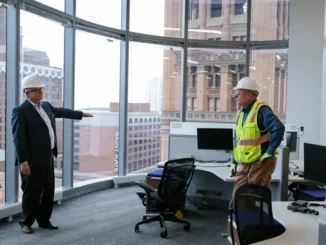
There is a clickbait argument that because the Federal Reserve has raised US interest rates so far and so fast, small banks — which provide almost 70 per cent of Commercial real estate lending — are likely to see significant defaults, and when those loans go bad they will face solvency issues. But to paraphrase Mark Twain, “reports of bank deaths are greatly exaggerated”.
CRE does pose risks for US lenders, but they should be manageable. According to Bloomberg analysts, US banks and thrifts hold 39 per cent of outstanding commercial real estate debt. Of that, small lenders — defined by the Federal Reserve as those outside the top 25 by assets — hold about two-thirds. Roughly 32 per cent of total CRE debt is repackaged into commercial mortgage-backed securities (CMBS) held by federal agencies and mortgage pools. And around 10 per cent of CRE loans are held by insurance companies.
Since banks are still the biggest category of CRE lenders and therefore the most exposed to risk, the bank failures of mid-March and recent high-profile defaults in the US by property giants such as Brookfield and Pimco have underscored the potential for stress. According to S&P Global, the number of banks exceeding regulatory guidance on CRE loan concentration rose for the seventh consecutive quarter in the final three months of last year. Commercial real estate is facing a trifecta of challenges.
Rising interest rates have reduced the net present value of properties and have pushed up mortgage costs. According to the RCA CPPI National All-Property Index, US commercial property prices have fallen 9 per cent over the past seven consecutive months.
This drop, when annualised, is the biggest since 2010. According to Trepp, $270bn in commercial mortgages held by banks are set to mature this year, the highest on record. Higher interest rates mean rolling that debt over will be costly. Consequently, sales volumes have dropped to levels not seen in a decade (excluding the depths of the pandemic).
And finally rents in CRE have been soft as a shift to working from home has sapped demand for office space. It is easy to think of real estate and have automatic flashbacks to 2008, when residential mortgages brought the global financial system to its knees. But commercial real estate only accounts for about 30 per cent of the US mortgage market, according to Capital Economics.
The overall sums lent against commercial buildings are much smaller than the loans extended to finance people’s homes. Defaults might take a while to materialise. Strategas’ model of the 25 banks with the highest percentage of CRE loans shows that only one has a high default risk over the next 12 months and just two others show elevated risks.
Delinquencies have remained low, in part because growth of rents — while weak — has stabilised and occupancy has continued to improve following the pandemic. Bankers have also learnt the lessons of subprime lending in 2008. The Fed’s Senior Loan Officer Opinion Survey reveals that almost 70 per cent of banks tightened lending standards for CRE credit in the final quarter of 2022.
More than half of banks expect lending conditions to continue tightening this year across all categories of CRE. Finally, not all CRE is the same. Office loans are the most at risk, particularly those with floating rates loaned against tall skyscrapers.
According to Bloomberg, 10 per cent of CMBS for offices maturing soon are already distressed and an additional 32 per cent are on the watch list. But the big office building workers are not coming back, and tend to be in large cities such as San Francisco and New York, where CRE loans are often drawn from larger banks.
Fed stress tests show large banks should have the necessary capital and liquidity buffers to absorb losses on deals gone bad. Smaller banks tend to have local knowledge of real estate conditions and strong relationships with borrowers.
Community banks in particular tend to be more exposed to loans for small suburban buildings, and loans to residential builders collateralised by land. Much of their “CRE lending” is for projects such as doctors’ and lawyers’ offices — businesses that are unlikely to default in the current economic environment.
Some loans will always go bad in difficult times, and recent bank wobbles have triggered concerns about CRE as the next shoe to drop. We should expect some defaults as interest rates continue to climb. But the nature of CRE lending suggests fears of a 2008 redux are also greatly exaggerated.
Source: www.ft.com



